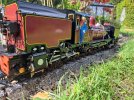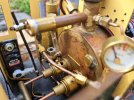I seem to have broken the sight glass on my NG16..... not sure how, but the loco was stationary and just building up pressure prior to running and the driver was suddenly covered in steam and hot water 
I've stripped down motion on a loco before (on a Mortimer), but never the 'plumbing' in a cab. Assuming I can obtain a replacement sight glass (from Accucraft?) then I guess it's a case of unscrew the nuts and replace the glass. One question, please, is do I use PTFE tape or just tighten the nuts back up? and are they just hand tight?
Where the water comes out of the boiler into the bottom of the sight glass has some steam seepage when running so I'll replace this washer at the same time (the red one on the photograph ) and hope that solves the problem. In fact, as there is no sight glass holding it, this whole assembly (to the left of the burners) moves from side to side. Does this seem right, or should it be solid?
Any knowledge on this would be much appreciated


I've stripped down motion on a loco before (on a Mortimer), but never the 'plumbing' in a cab. Assuming I can obtain a replacement sight glass (from Accucraft?) then I guess it's a case of unscrew the nuts and replace the glass. One question, please, is do I use PTFE tape or just tighten the nuts back up? and are they just hand tight?
Where the water comes out of the boiler into the bottom of the sight glass has some steam seepage when running so I'll replace this washer at the same time (the red one on the photograph ) and hope that solves the problem. In fact, as there is no sight glass holding it, this whole assembly (to the left of the burners) moves from side to side. Does this seem right, or should it be solid?
Any knowledge on this would be much appreciated


